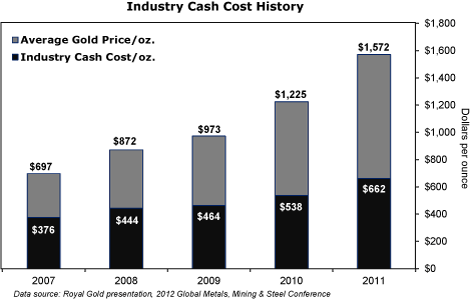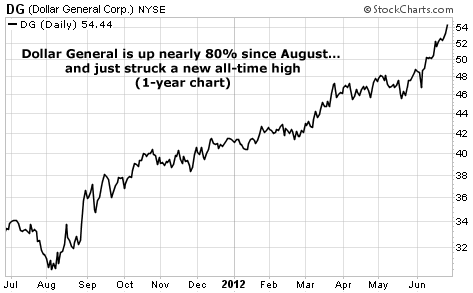| Home | About Us | Resources | Archive | Free Reports | Market Window |
A Warning for Gold Stock InvestorsBy
Wednesday, June 27, 2012
Aaron Regent just lost his job.
A month ago, Aaron was the CEO of Barrick Gold, one of the world's largest, most successful gold-mining companies. He earned over $8 million in 2011, making him one of Canada's highest-paid executives.
But two weeks ago, Aaron was fired.
He wasn't fired for participating in secretive deals (like Aubrey McClendon, who lost his job as Chairman of Chesapeake Energy)... and it wasn't because of a sexual harassment case (like the one that brought down Hewlett-Packard CEO Mark Hurd a few years ago).
Aaron was fired because the cost of producing an ounce of gold is soaring.
You see, there's a problem in the gold industry that few people talk about. It's causing gold stocks to plummet. It's causing CEOs to get fired. And it could result in most gold companies going bankrupt over the next few years.
If you're invested in this space, you need to be aware of what's going on...
The problem is, the cost of producing an ounce of gold is soaring.
Barrick management hinted at this problem when it fired Aaron. The company said the cost to produce an ounce of gold has risen from $460 an ounce last year to $560 an ounce this year. That's an increase of 22% in just 12 months.
That's a giant increase in production costs in such a short time... And it's causing gold mining profits and share prices to fall. For example, Barrick's share price fell 29% in just three months this year. And even though gold prices have skyrocketed over the past four years, Barrick's shareholders haven't made a dime. The company's share price is right where it was in 2008.
You might not realize it, but producing an ounce of gold is an extraordinarily expensive achievement.
First, it takes a lot of money to search for deposits... You have to pay for permits, drilling, and labor. Much of the time, these deposits are located in harsh climates like jungles and deserts. And if by some miracle you happen to find gold, it could take a decade or more before you start seeing profits.
Then, you have to spend hundreds of millions of dollars to build the infrastructure needed to extract the gold. This includes heavy equipment, mine infrastructure, roads, costly labor, electricity, and fuel.
You also have to stay in good standing with the local governments. In short, even if a miner spends $100 million or more developing a successful mine in Africa, the government could change its tax structure on a dime. This could result in significant losses after years of development.
As you can see from the chart below, the cost of all these steps is rising... which is cutting heavily into gold miner profits...
 This data is through 2011. And prices are still surging in 2012. Just take a look at what the CEOs of a couple of the top gold-producing companies have said about costs over the past few months:
Mark Cutifani, CEO of AngloGold Ashanti: "If you want to go on a total cost basis, we're running at about $1,200. The industry average is probably around $1,250 an ounce."
Steve Letwin, CEO of Iamgold: "It's going to be difficult for anybody to produce gold at less than $1,200 an ounce."
This month, I spoke with gold expert John Doody, editor of the excellent Gold Stock Analyst newsletter. He's been writing about gold stocks for more than three decades – and is one of the smartest analysts in the industry. He told me most gold companies are now paying more than $1,000 to produce an ounce gold.
The costs have risen significantly over the past six months because companies have to dig deeper to find high-grade gold deposits. In many cases, that means digging more than one mile into the ground. In addition, costs associated with almost everything I mentioned above have moved higher over the past year.
The current gold price is roughly $1,600 an ounce. As I just showed you, some of the top CEOs in the mining industry predict production costs will rise to more than $1,000 an ounce.
If you're wondering why gold stocks are struggling, this is why. If you're looking to buy a gold stock, take a close look at its production costs. Companies update their production costs each quarter when they report earnings. You can find that information on each company's website or by listening to the company's quarterly webcast.
Some companies with excellent mines are managing to keep the rising costs manageable. Some companies are not. If a gold producer's profits are getting eaten away by production costs, so will your investment money.
Good investing,
Frank Curzio
Further Reading:
Last month, our sister site The Daily Crux scored an exclusive interview with John Doody. In it, he shares his insights on gold stocks... and two of his favorite buys. Access this interview – free to Crux subscribers – here: What the world's best gold stock analyst is thinking now.
Market NotesTHE "LOW-END UPTREND" CONTINUES Few uptrends survived the market's spring selloff… but the "low-end uptrend" barely blinked…
Take Dollar General (NYSE: DG), for example. Dollar General is one of America's largest "discount retailers." Its stores aren't located in "prime" locations. It doesn't sell "prime" brands. It sells cheap stuff in low-end shopping centers.
But buying quality isn't "job one" for a lot of American families right now. That's why Dollar General's revenues and profits are growing. It opened up another 500 stores this year. And its stock held steady during the big April-May selloff this year.
As you can see in the chart below, the stock hasn't just held steady. Yesterday, it struck a new high. Dollar General's peers – Family Dollar, Dollar Tree, and even retail giant Wal-Mart – all sport similar chart patterns. So do many of the companies that make "the basics," like cigarettes and beer. The "low-end uptrend" continues.
– Brian Hunt
 |
In The Daily Crux
Recent Articles
|


